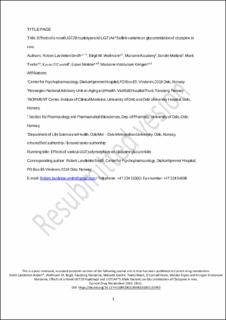| dc.contributor.author | Smith, Robert Løvsletten | |
| dc.contributor.author | Wollmann, Birgit Malene Tovik | |
| dc.contributor.author | Kausberg, Marianne | |
| dc.contributor.author | Mæland, Sondre | |
| dc.contributor.author | Tveito, Marit | |
| dc.contributor.author | O'Connell, Kevin Sean | |
| dc.contributor.author | Molden, Espen | |
| dc.contributor.author | Kringen, Marianne K. | |
| dc.date.accessioned | 2023-02-17T08:21:17Z | |
| dc.date.available | 2023-02-17T08:21:17Z | |
| dc.date.created | 2022-02-07T10:35:29Z | |
| dc.date.issued | 2022 | |
| dc.identifier.citation | Current drug metabolism. 2022, 23 (1), 66-72. | en_US |
| dc.identifier.issn | 1389-2002 | |
| dc.identifier.issn | 1875-5453 | |
| dc.identifier.uri | https://hdl.handle.net/11250/3051782 | |
| dc.description.abstract | Background: Glucuronidation is an important metabolic pathway of clozapine (CLZ), but the impact of various uridine 5'diphospho-glucuronosyltransferases (UGT) polymorphisms on the exposure and metabolism of CLZ in vivo is unclear. Objective: The objective of this study was to investigate the impact of UGT2B haplotype and UGT1A4*3 allele variants on the formation of CLZ glucuronide metabolites (5N- and N+-glucuronide) and CLZ exposure in patients’ serum after adjusting for sex, age, and smoking habits. Methods: The study was based on serum samples from CLZ-treated patients (n=79) subjected to routine therapeutic drug monitoring (TDM) at Diakonhjemmet Hospital, Oslo, Norway. From the same patients, the following UGT variants were genotyped using Real-Time PCR: UGT2B:GA haplotype (defined as UGT2B:GA; rs1513559A>G and rs416593T>A) and UGT1A4*3 (rs2011425T>G). Serum concentrations of CLZ 5N- and N+-glucuronide were measured by UPLC high-resolution mass spectrometry. Results: None of the genotypes had significant impact on CLZ exposure (p>0.05). However, compared to UGT2B:AT/AT and UGT1A4*1/*1, the 5N-glucuronide exposure was reduced in UGT2B:GA/GA carriers (-75 %, p=0.03) while the exposure was non-significantly increased in UGT1A4*3 carriers (+100 %, p=0.14), respectively. The N+-glucuronide exposure was unchanged in UGT1A4*3 vs. noncarriers (p=0.28), but significantly reduced in heterozygous (-50 %, p=0.016) and homozygous carriers (-70 %, p=0.021) of UGT2B:GA compared to UGT2B:AT/AT carriers, respectively. Conclusion: The UGT2B:GA and UGT1A4*3 variants had no impact on CLZ exposure but were associated with differences and preferences in CLZ glucuronidation. The latter might be of potential relevance for CLZ tolerability since levels of the N+-glucuronide metabolite may reflect the generation and trapping of reactive metabolites involved in CLZ-induced toxicity | en_US |
| dc.language.iso | eng | en_US |
| dc.publisher | Bentham Science Publishers | en_US |
| dc.relation.ispartofseries | Current drug metabolism;Volume 23, Issue 1 | |
| dc.subject | Clozapine | en_US |
| dc.subject | Uridine 5'-diphospho-glucuronosyltransferase | en_US |
| dc.subject | Therapeutic drug monitoring | en_US |
| dc.subject | Glucuronidation | en_US |
| dc.subject | Metabolisms | en_US |
| dc.subject | High-resolution mass spectrometry | en_US |
| dc.title | Effects of a Novel UGT2B Haplotype and UGT1A4*3 Allele Variants on Glucuronidation of Clozapine In vivo | en_US |
| dc.type | Peer reviewed | en_US |
| dc.type | Journal article | en_US |
| dc.description.version | acceptedVersion | en_US |
| cristin.ispublished | true | |
| cristin.fulltext | postprint | |
| cristin.qualitycode | 1 | |
| dc.identifier.doi | https://doi.org/10.2174/1389200223666220201152953 | |
| dc.identifier.cristin | 1998434 | |
| dc.source.journal | Current drug metabolism | en_US |
| dc.source.volume | 23 | en_US |
| dc.source.issue | 1 | en_US |
| dc.source.pagenumber | 21 | en_US |
| dc.relation.project | Helse Sørøst: 2016097 | en_US |
| dc.relation.project | Horisont 2020: EC/H2020/964874 | en_US |
